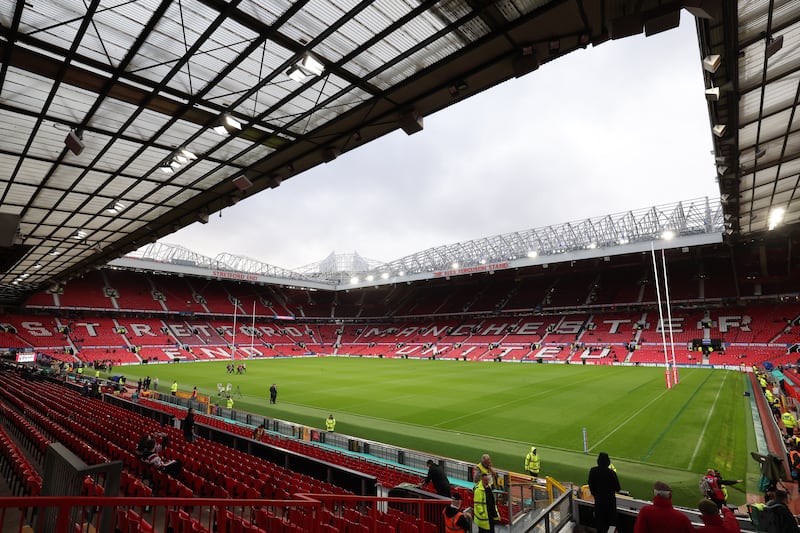There was no shortage of gasps on social media on Thursday morning. The BBC had released an interview with Jim Ratcliffe, who made it big in chemicals, is worth about €20 billion, and recently acquired more than 25 per cent of Manchester United for €1.2 billion.
Ratcliffe believes that the Old Trafford ground, which has a roof that has been leaking for a decade and is badly in need of an extensive refurb or rebuild, should become “The Wembley of the North” at a cost of more than €2 billion. During the conversation, it became clear that in his view it wouldn’t just be United’s money that should pay for it.
“I think, as part of a regeneration project, there has to be a conversation with the national government,” Ratcliffe explained. “The north deserves some thought as well as the south, I think, if it is a national stadium.”
In Ireland this week there was much talk about Casement Park, with the Irish Government committing €800 million in funding to projects in Northern Ireland as part of the Shared Island initiative, including €50 million towards the redevelopment of the GAA ground in West Belfast, where the total cost could run to more than €300 million.
Last November, Eddie Hearn sought a dig-out to ensure Katie Taylor’s next fight was at Croke Park. He voiced his belief that the Irish Government should support the fight and help make it happen.
The promoter added that he felt “driven to deliver it for what I feel is Ireland’s greatest-ever athlete”, and believed the Irish authorities, which have financially supported many major sporting events in the past, could help make such a contest a reality.
“That involves the Government. And that involves us putting together a strategic plan for the Government and the tourism agencies to actually show them the benefit of such an event,” he added.
Looking to governments for financial support for events or stadiums that will ultimately enrich other organisations or individuals is a not a new phenomenon.
The big three of the GAA, IRFU and FAI have all received public money for Croke Park, Aviva Stadium and smaller arenas, while the IRFU received considerable taxpayer funding to campaign for a failed Rugby World Cup bid.
At the end of last year, the Government awarded more than €37 million in so-called top-up sports grants, including an additional €5 million for the redevelopment of Leinster Rugby’s home ground at the RDS and €10 million for Connacht Rugby. The grants were in addition to €86 million worth of grants handed out in 2020.
The single biggest award went to Connacht, which doubled the original grant awarded for the redevelopment of their home venue, the Sportsground in Galway. The grant for the redevelopment of the RDS main arena, where the annual Dublin Horse Show also takes place, was bumped up to €15 million overall.
The Government also awarded an additional €5.1 million for Athletics Ireland and Community Sport Projects, bringing their total grant to €14.3 million. Why?
Buy into it, and sport – participating or watching – is good for you, good for individuals, good for communities and good for countries. Governments see that.
Take the 2028 Euros in Andersonstown. Wouldn’t that be something. And it will happen, if former football referee and UK Secretary of State Chris Heaton-Harris sees it as worthwhile. The buy-in is a demonstration to the world that with peace comes progress and stability in a city not known for those things. From there, it can reach out for more.

Stadiums are the leading edge of the notion “can’t see, can’t be”. Visibility is important. Stadiums dominate skylines. They are latter-day monuments to popular culture. More than concrete and steel, they are also story-tellers. The past comes with them.
Cathedrals of their day, they are significant generators of community vitality, bringing together people who want to feel a part of something larger than themselves.
Old Trafford, Croke Park, Madison Square Garden, Thomond Park, Stade de France or Wembley – walk into them and they animate, arouse and embolden. They inspire people to play, and that strengthens social relationships, brings people together from different backgrounds and creates a sense of shared purpose and identity.
To believe in committing millions to buildings, you must fully commit to the belief that participation provides productive outlets, and keeps people focused and engaged.
A sport such as boxing goes where many others don’t, mining disadvantaged communities for talent, fostering self-esteem and reducing vulnerability to harmful social influences. Soft skills come for free – perseverance, teamwork, leadership, gender equality.
[ Government funding top-ups help GAA recommence development projectsOpens in new window ]
There are many reasons why states believe in building sports grounds and staging events, although the many shaking, disbelieving heads are understandable.
Handing money to United to pay for Old Trafford, propping up an English boxing promoter for a Katie homecoming in Croke Park, or pouring money into Casement Park during a housing crisis are understandably uncomfortable subjects for many.
But that’s what investment is. It’s about enlightenment and the “trust me” factor that the millions are worth it. It’s about the downstream effect. It’s about buying in, if you can buy that.

















